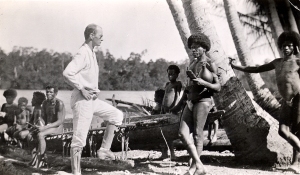Viva Observational Cinema
This post intends to explore the materiality of death that imbues everyday living in the holy city, Benares, presented to the viewer through the Gardner’s ethnographic inquiry and visual narrative. The materiality of the movie, I believe, is achieved with the no-intervening and purely observational camera of the director. Gardner chose a rich visual vocabulary to comprehend and present reality. The meaningful use of sound and visual helps Gardner convey his film’s messages without any need for voice-over or text. In the first section of this I will show how this pure observational movie functions and in the second part I will compare Forest of Bliss with the movie Children Underground (2001) shot in the subways and squats of Bucharest, Romania. I like to question to what extent an observational can inform the viewer and does it have any any implications?
This 90 minute film shows the entanglement of profanity and sacredness of a much-studied city, Benares, in the span of a day from sunrise to sunset through pictorial representation, without subtitles and voice-over narration. Gardner’s refusal to interpret individuals as anything but visual motifs is the most provocative aspect of his movie in which no translations, explanations, or context are given to the audience to comprehend the floating sequences before their eyes. Gardner’s non-interfering camera turns the spirituality of death burials to a flattened materiality which challenges any transcendence. This pure observational camera is how Gardner “subscribes” himself to the “truth”. It seems as if the only intention of the director is to visually capture in great detail the sequence of life as it ebbs away to give way to eternal bliss by recording the anticipation of death among the inmates of the hospice, subsequent preparation of the corpse for cremation, and its final journey to the last rites.
Not giving explanation to the viewer provoked a series of cities of the movie. Moore insists that despite the pictorial richness of the movie, the lack of narration perplexes the audience. Parry sympathizes with Moore and other viewers of the film who cannot possibly ‘‘know’’ the significance of these visual presentations from the narrative without deep ethnographic knowledge of Indian rituals, coming out horrified or confused instead of being more informed about the anthropology of the city’s activities. However, within the first few minutes of the film, Gardner captures some metaphoric elements such as the boat, river, flower and stairs that play crucial roles in unfolding the whole story. The non-linear narrative and a supposedly random montage of, bodies and cremation in the beginning of the movie leads the viewer through the camera’s eye to uncover answers, piece together a puzzle, and evolve a story.
I believe what Moore ignores in his analysis is not taking into consideration the auditory aspect of the movie. the sound accompanying the imagery plays both an unconventional and contentious role in the film, for it does not occur in the expected fashion to explain through dialogue or voice-over narration any words or actions on the screen. At first instance, it seems that Gardner, in his commitment to observational cinema, has not undertaken any directorial initiative to explore the possibilities of sound, yet closer examination reveals his sensitivity to a naturally originating score and indeed a carefully selected rhythm. Almost every scene has a repetitive sound that paces the visuals, for instance sounds of a squeaking oar, clanging bells, and footsteps on stairs, repetitive barking or the chanting of prayers by priests. Repetition of both sound and vision in fact provides this rhythm, establishes connections, and reasserts truth in the narrative through constant verification in similar scenes. Gardner’s method seeks to coordinate recurrent sights with sounds in the course of a day. The splitting of wood and rowing of boats are also captured in multiple scenes with the same evenly paced sounds reverberating for the listening viewers. Gardner’s film educates the audience to receive and understand filmic narrative through a novel, cyclical method of presentation that integrates vision and sound both rich enough to not require verbal or textual explanation.
What makes me wonder is to what extent we can use an observant in an ethnographic film. On one hand, not giving any explanation and context to the viewer may open up different interpretations which might not have any ground in reality. On the other hand, the viewer does not feel any burden of an authoritative voice or text leading him step by step throughout the movie. Watching children underground, I faced with another important question. The camera in both forest of bliss and children underground is indifferent toward the agony that captures. In the latter movie, the camera intimately, unsentimentally captures the dire situation of nihilistic street kids, some as young as 8, as they starve, fight, sniff paint and eke out a chaotic existence. The observational style in this case allows the film to make a potent social and political statement about the consequences of the despotic Ceaucescu regime, without being polemical. Although this movie was criticized on the ethical ground, I believe it did what it wanted to do. What the viewer faces in this movie is the starkness of reality which is neither mitigated by any poetic frills nor even music.
What I understood and felt watching these two films is that reality in the movie is more realizable when it is not accompanied with any kind of interference of the director, text or authoritative voice. And viva observational cinema.







